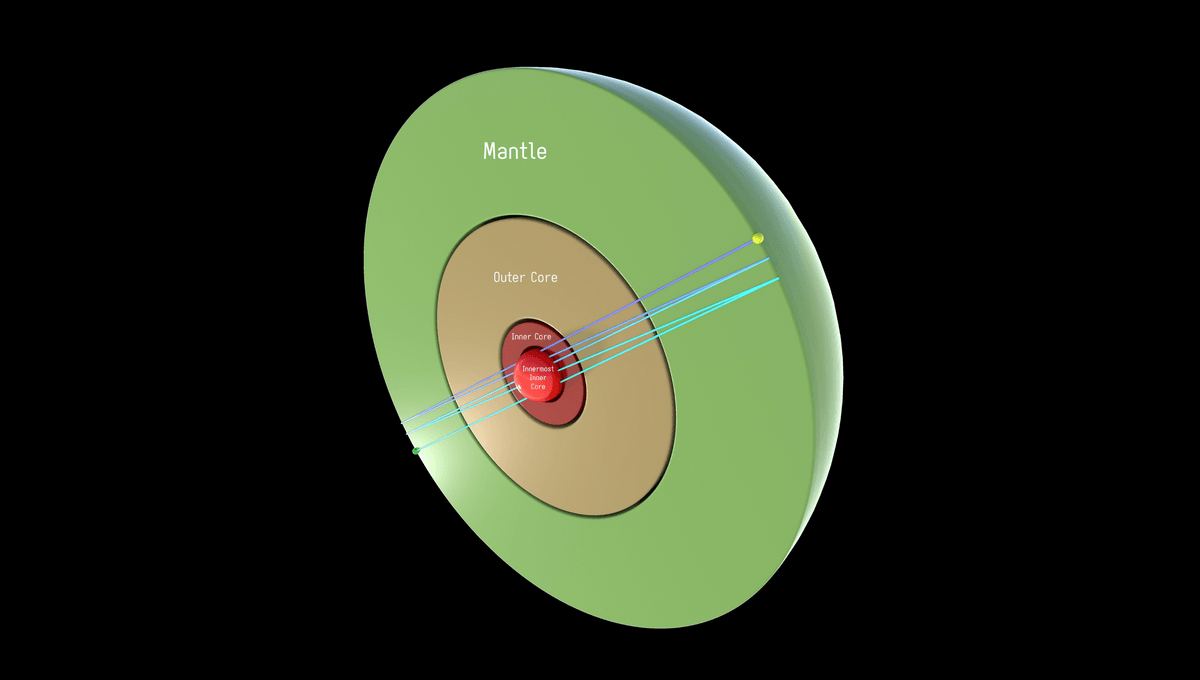
Like an onion or a set of Russian dolls it seems the there is no end to the Earth’s internal structure. New research indicates the component known as the “inner core” consists of an innermost core and a middle core (still called inner). Although both are probably made of solid iron and nickel, it seems the two may be sufficiently differentiated that they need to be treated separately if we wish to understand the formation and behavior of our planet.
Humanity’s knowledge of the inner workings of our planet depends on earthquakes. Seismic waves produced during quakes bounce off boundaries within the planet or get bent, like light waves reflecting or refracting from a change of medium. The deeper one goes, however, the harder these are to study, both because only waves passing almost directly through the center of the planet are affected, and because of the noise created by interactions at boundaries further out.
Consequently, while an innermost core has been hypothesized for more than 20 years, its existence has remained uncertain. Dr Thanh-Son Phạm and Professor Hrvoje Tkalčić of the Australian National University claim in a new paper that they have finally confirmed it. To get their answer they used delays in the arrival times of seismic waves from 200 earthquakes of magnitude 6 or over that have bounced back and forth through the Earth, in some cases passing five times. The previous highest recording was two passages, with a single bounce off the crust.
Phạm and Tkalčić describe the innermost core as a solid “metallic ball” 650 kilometers (400 miles) across, making it smaller than Ceres, but larger than any other main belt asteroid. Seismic P-waves travel through it 4 percent more slowly when along a path angled 50 degrees to the Earth’s rotational axis. The authors interpret this as a sign it has a crystalline structure caused by the way iron atoms arrange themselves at very high temperatures and pressures. Movement through the rest of the solid core is slowest in the direction of the equatorial plane.
“This inner core is like a time capsule of Earth’s evolutionary history – it’s a fossilised record that serves as a gateway into the events of our planet’s past. Events that happened on Earth hundreds of millions to billions of years ago,” Tkalčić said in a statement. The authors suggest a major global event caused the innermost core to differentiate from the rest of the inner core, although they don’t yet know what this was.
The inner core as a whole is believed to be growing as parts of the liquid outer core solidify. However, we don’t know if the boundary between the innermost core and the surrounding shell is shifting.
The work was possible, the authors report, because of the increasing number of seismic sensors distributed around the planet. By casting a wide net and combing results from many locations the authors were able to track seismic waves in unprecedented detail, including some travelling north-south almost directly through the Earth. They also developed techniques to boost the signal from the distant seismic waves, distinguishing it from localized noise.
The authors propose that future research investigate the boundary between the innermost core and the shell around it. Last year, Tkalčić and another colleague challenged the thinking about the internal structure of Mars, having provided evidence its mantle still has mobile magma, rather than having cooled to a solid husk.
The paper is published in Nature Communications.
Source Link: The Earth May Have A Core Within Its Core Within Its Core